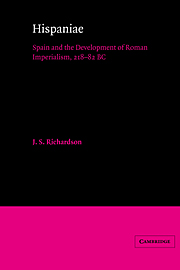Book contents
- Frontmatter
- Contents
- List of maps
- Preface
- Abbreviations
- 1 Spain and Roman imperialism
- 2 Spain before the Romans
- 3 The war zone: 218–206
- 4 Continuity and adaptation: 206–194
- 5 The shaping of the provinciae: 193–155
- 6 The consular provinciae: the wars in Spain 155–133
- 7 From provinciae to provinces: 133–82
- 8 Rome, Spain and imperialism
- Appendices
- Bibliography
- Index
8 - Rome, Spain and imperialism
Published online by Cambridge University Press: 07 September 2009
- Frontmatter
- Contents
- List of maps
- Preface
- Abbreviations
- 1 Spain and Roman imperialism
- 2 Spain before the Romans
- 3 The war zone: 218–206
- 4 Continuity and adaptation: 206–194
- 5 The shaping of the provinciae: 193–155
- 6 The consular provinciae: the wars in Spain 155–133
- 7 From provinciae to provinces: 133–82
- 8 Rome, Spain and imperialism
- Appendices
- Bibliography
- Index
Summary
The Spain from which C. Valerius Flaccus returned to Rome in 81, at the end of his protracted term in Hispania Citerior and Transalpine Gaul, was from the Roman viewpoint a very different area from that to which P. Scipio had been sent in 218. Scipio went to his provincia to fight the Carthaginians and it is likely that most members of the senate at that time had rather less interest in Spain as such than the average member of the British House of Commons had in the Sahara desert in 1942, at the time of the battle of El Alamein. By the 80s BC the two provinciae contained substantial numbers of Romans and Italians, both military and civilian, and many of the indigenous communities had developed close links with these representatives of the Roman power.
Apart from the army itself, this Roman presence must have been most obvious in the settlements of Roman origin, both those such as Valentia (modern Valencia) which appear to have been founded on previously unoccupied sites, and those in which an already existing indigenous population was either replaced or absorbed. Most of these settlements seem to belong to this second category, and it is possible that at Italica and Corduba, two separate communities, Iberian and Italian, lived in distinct quarters. Of the archaeological remains discovered so far, there is little to suggest that these towns would have displayed very much ‘Romanness’ in the grandeur of their buildings, but by the early years of the first century the influence of Hellenised Roman architecture was already being seen in at least some indigenous communities.
- Type
- Chapter
- Information
- HispaniaeSpain and the Development of Roman Imperialism, 218–82 BC, pp. 172 - 180Publisher: Cambridge University PressPrint publication year: 1986

